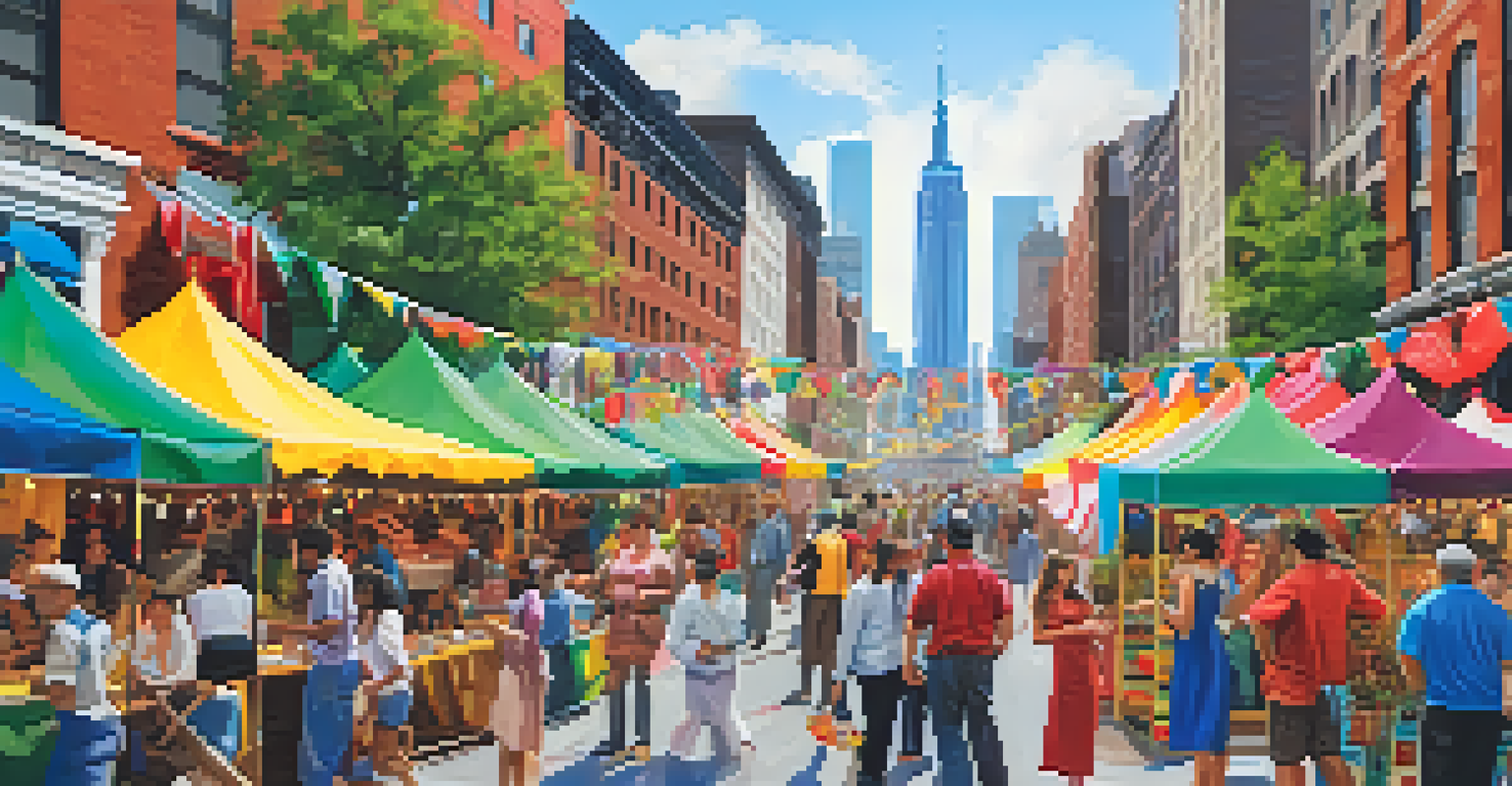Cultural Institutions: Economic Pillars in New York City

The Role of Cultural Institutions in Economic Growth
Cultural institutions like museums, theaters, and galleries are more than just places to enjoy art; they are vital engines of economic growth in New York City. They provide jobs, attract tourists, and stimulate local businesses. For example, the Metropolitan Museum of Art not only showcases world-class art, but also supports thousands of jobs directly and indirectly.
Cultural institutions are the heart of a community, offering a space for creativity and connection that drives economic growth.
These institutions often serve as cultural landmarks, drawing both residents and visitors alike. A bustling cultural scene can enhance the attractiveness of a neighborhood, creating a ripple effect that benefits restaurants, shops, and hotels. This interconnectedness highlights how cultural institutions contribute to the larger economic ecosystem of the city.
Moreover, with their capacity to host events, exhibitions, and performances, cultural institutions foster community engagement and tourism. They become gathering spaces that encourage interaction, collaboration, and creativity, ultimately making New York City a more vibrant place to live and work.
Job Creation and Employment Opportunities
Cultural institutions are significant employers in New York City, providing a wide range of job opportunities. From curators and educators to administrative staff and maintenance workers, these organizations employ thousands of individuals. This diverse job market not only supports the economy but also nurtures talent in various fields, including arts management and education.

Additionally, many cultural institutions offer internships and volunteer programs, fostering the next generation of professionals. These programs can be invaluable for students and young adults seeking to gain experience in the arts sector. By equipping them with essential skills, these institutions play a crucial role in workforce development.
Cultural Institutions Drive Economy
Cultural institutions in NYC create jobs, attract tourists, and stimulate local businesses, significantly contributing to the economy.
The employment generated by cultural institutions also extends to related industries. When people attend events, they often dine at nearby restaurants or shop at local stores, leading to a further increase in job opportunities across different sectors. In this way, the cultural sector creates a thriving job market that benefits the entire city.
Tourism: A Major Economic Driver
New York City's cultural institutions are among the biggest attractions for tourists from around the globe. Iconic spots like Broadway theaters and the Museum of Modern Art draw millions of visitors each year. This influx of tourists not only enriches the cultural landscape but also injects significant revenue into the city's economy.
The arts are not a luxury; they are a necessity that enriches our economy and our lives.
Tourists visiting these institutions often spend money on transportation, dining, and shopping. Studies show that cultural tourists are typically willing to spend more than average visitors, making their contribution to the local economy even more impactful. This spending helps sustain local businesses and creates a thriving hospitality industry.
Furthermore, many cultural institutions collaborate with travel agencies and hotels to create packages that enhance the visitor experience. These partnerships not only promote the arts but also bolster the economic benefits derived from tourism, creating a win-win situation for both the institutions and the city.
Community Engagement and Social Impact
Cultural institutions are not just about economic impact; they play a crucial role in community engagement and social cohesion. By offering educational programs and outreach initiatives, these organizations foster a sense of belonging and inclusivity among diverse populations. They create spaces where people from various backgrounds can come together to learn and share experiences.
For instance, many museums hold free or discounted days to ensure access for all, regardless of socioeconomic status. These initiatives help demystify art and culture, making them more accessible to a broader audience. As a result, cultural institutions contribute to building a more informed and engaged community.
Community Engagement Through Culture
These institutions foster community engagement and inclusivity by offering educational programs and accessible events for diverse populations.
Moreover, events and festivals organized by these institutions often reflect the cultural diversity of New York City, celebrating different traditions and histories. This not only enriches the local culture but also promotes understanding and appreciation among residents, further solidifying the role of cultural institutions as pillars of the community.
Sustainability Initiatives in Cultural Institutions
Many cultural institutions in New York City are taking strides towards sustainability, recognizing their responsibility to the environment. Initiatives such as green building certifications and energy-efficient practices are becoming standard. For instance, institutions like the American Museum of Natural History are implementing measures to reduce their carbon footprint.
Implementing sustainable practices not only benefits the planet but also attracts visitors who value environmental stewardship. By showcasing their commitment to sustainability, these institutions can enhance their reputation and appeal to eco-conscious tourists. This alignment with the values of their audience can lead to increased attendance and support.
Additionally, sustainability initiatives can also lead to cost savings in the long run. By reducing energy consumption and waste, cultural institutions can allocate more resources towards programming and community outreach, ultimately reinforcing their role as economic and cultural pillars in the city.
The Impact of Technology on Cultural Institutions
In the digital age, technology has transformed the way cultural institutions engage with their audience. From virtual tours to interactive exhibits, technology enhances the visitor experience and broadens access to art and culture. Institutions like the Guggenheim have embraced digital platforms to reach a global audience, showcasing their collections online.
Moreover, technology enables cultural institutions to gather data and better understand their visitors. By analyzing attendance patterns and feedback, they can tailor programs to meet the needs of their community. This data-driven approach not only improves visitor satisfaction but also helps institutions remain relevant in a rapidly changing landscape.
Sustainability Shapes Future Practices
Many cultural institutions are adopting sustainable practices, enhancing their appeal to eco-conscious visitors while benefiting the environment.
Additionally, technology can streamline operations within these organizations, making them more efficient and effective. By adopting new tools for management and marketing, cultural institutions can focus on their core mission: enriching lives through art and culture while contributing to the local economy.
The Future of Cultural Institutions in NYC
As New York City continues to evolve, cultural institutions must adapt to meet the changing needs of their communities. This includes addressing challenges such as funding cuts, competition from digital media, and shifting audience demographics. By embracing innovation and collaboration, these institutions can secure their place as vital economic pillars.
Looking ahead, partnerships between cultural institutions and local businesses will be crucial. By working together, they can create unique experiences that attract visitors and foster community engagement. For example, collaborations that merge art with local cuisine can draw in new audiences and celebrate the city's diverse culture.

Ultimately, the future of cultural institutions in NYC lies in their ability to remain flexible and responsive. By continuing to prioritize economic contributions while fostering community connections, they can ensure their ongoing relevance and impact in a city renowned for its rich cultural landscape.